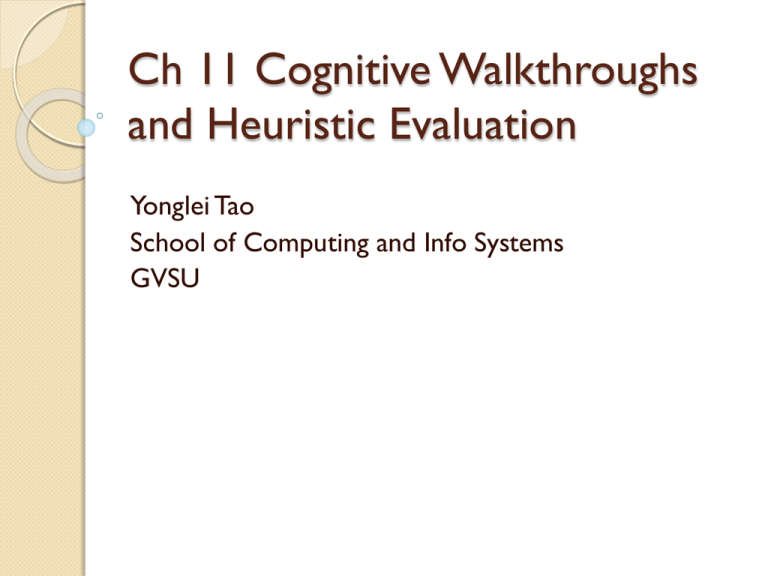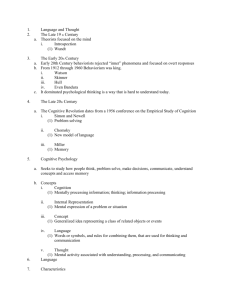Ch 11 Cognitive Walkthroughs and Heuristic Evaluation
advertisement

Ch 11 Cognitive Walkthroughs and Heuristic Evaluation Yonglei Tao School of Computing and Info Systems GVSU Heuristic Evaluation • Usability experts evaluates an interface according to a set of criteria • Follow a scenario through the design • Identify problem users would have when interacting with the interface • Make recommendations • Nielsen’s ten huristics www.useit.com/papers/heuristic/heuristic_list.html 1-2 Empirical Data Factor 1:Visibility of system status ◦ ◦ ◦ ◦ ◦ ◦ ◦ ◦ ◦ ◦ ◦ ◦ Feedback: keep user informed about what goes on Provide status information Feedback: show that input has been received Features change as user carries out task Feedback provided for all actions Feedback timely and accurate Indicate progress in task performance Direct manipulation: visible objects, visible results Identity cues system response vs. user’s goals Show icons and other visual indicators WYSIWYG: do not hide features What incorrect inferences are most likely Empirical Data (Cont.) Factor 2: Match between system and real world ◦ ◦ ◦ ◦ ◦ ◦ ◦ ◦ ◦ ◦ ◦ ◦ Speak the user’s language Contains familiar terms and natural language Speak the user’s language Metaphors from the real world Familiar user’s conceptual model Use of user’s background knowledge Learnable through natural, conceptual model Follow real-world conventions Screen representation matches non-computer Encourage users to import pre-existing tasks Identity cues between actions and user’s goals Understand the user’s language Empirical Data (Cont.) Factor 3: User control and freedom Undo and redo should be supported Obvious way to undo actions Forgiveness: make actions reversible Ability to undo prior commands Clearly marked exits Ability to re-order or cancel tasks Modeless interaction User control: allow user to initiate/control actions Modelessness: allow users to do what they want Empirical Data (Cont.) Factor 4: Consistency and standards ◦ ◦ ◦ ◦ ◦ ◦ ◦ ◦ Consistency: express same thing same way Consistency Consistency: same things look the same Uniform command syntax Conform to platform interface conventions Consistent key definitions throughout Universal commands: a few, generic commands Show similar info at same place on each screen Empirical Data (Cont.) Factor 5: Error prevention ◦ Prevent errors from occurring in the first place ◦ System designed to prevent errors ◦ Understand the user’s language ◦ What planning mistakes are most likely? ◦ What slips are most likely? ◦ Identity cues between actions and user’s goals Empirical Data (Cont.) Factor 6: Recognition rather than recall ◦ ◦ ◦ ◦ ◦ ◦ ◦ ◦ ◦ ◦ ◦ ◦ ◦ ◦ See-and-point instead of remember-and-type Make the repertoire of available actions salient Seeing and pointing: objects and actions visible All user needs accessible through the GUI What features often missed and at what cost? Provide lists of choices and picking from lists Minimize the users’ memory load Direct manipulation: visible objects, visible results Easy or difficult to perform (execute) task? Evoke goals in the user Allow access to operations from other apps. Clearly marked exits Show icons and other visual indicators Integrated with the rest of the desktop Empirical Data (Cont.) Factor 7: Flexibility and efficiency of use ◦ ◦ ◦ ◦ ◦ ◦ ◦ ◦ ◦ Accelerators should be provided Shortcuts: Accelerators to speed up dialogue User tailorability to speed up frequent actions User control: allow user to initiate/control actions System should be efficient to use User interface should be customizable Ability to re-order or cancel tasks Keyboard core functions should be supported Physical interaction with system feels natural Interactive Heuristic Evaluation Toolkit Allows you to do either of the following: - View a list of the suggested heuristics for a particular type of electronic device, or - Select your own heuristics for a type of device and then compare your selections against a list of suggested heuristics http://www.id-book.com/catherb/ Cognitive Walkthroughs An evaluator steps through the action sequence for a task and check the design for potential usability problems Role-plays the part of a typical user and tries to accomplish that user’s tasks 1-11 Cognitive Walkthroughs Questions to ask at each step ◦ Will users know what to do? ◦ Will users see how to do? ◦ Will users understand from feedback whether the action was correct or not? Example of Cognitive Walkthroughs Example of Cognitive Walkthroughs A Scenario – Read Poems from Multiple Issues From the Home page, click on the Issues link 2. From the Issues page, decide on an issue to look at 3. Click on the appropriate issue link 4. Scan the TOC for a poem 5. Click on the poem’s link 6. Read the poem 7. Click on the global Issues link 8. Repeat steps 2-6 1.








